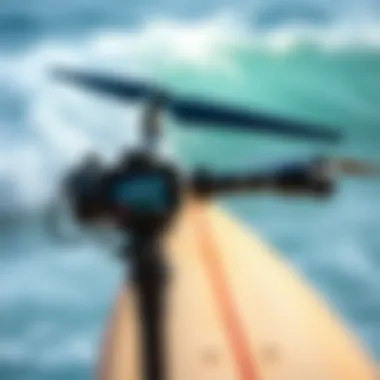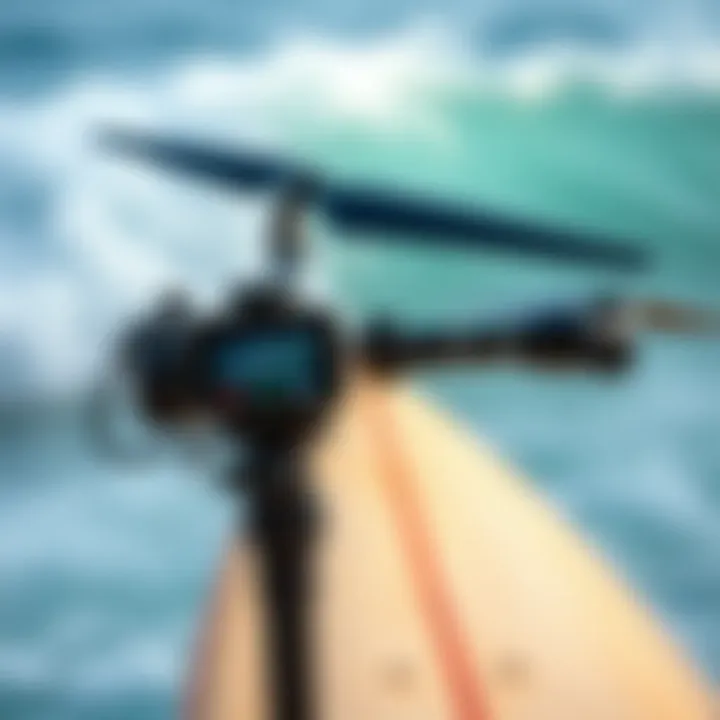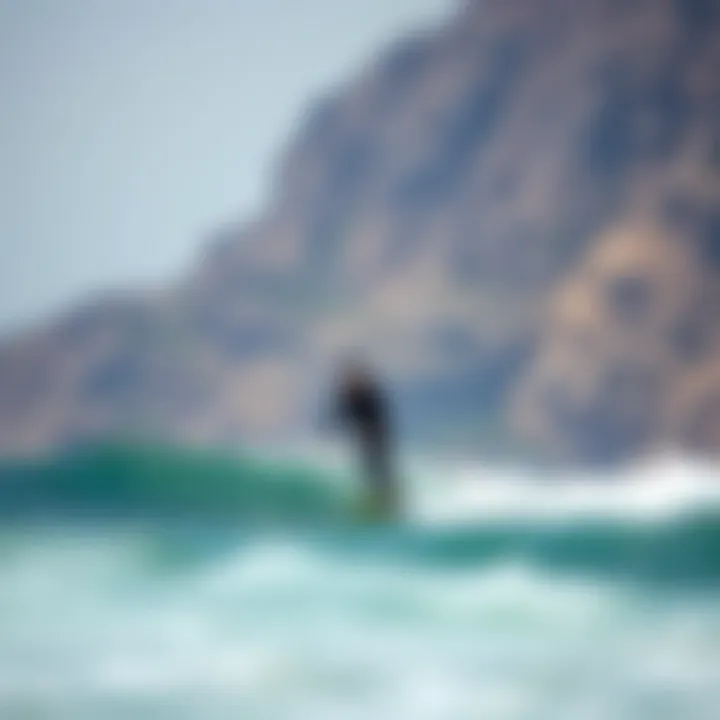Comprehensive Guide to Understanding Wind Direction


Intro
Understanding wind direction is not just a matter of curiosity; it's an essential skill, especially for surfers and outdoor enthusiasts. Knowing which way the wind blows can profoundly affect your surfing experience, impacting wave quality and even safety. This article aims to shed light on practical methods and tools for determining wind direction, empowering you to make informed decisions whether you’re at the beach or out hiking.
Why Wind Direction Matters
Before diving into the nitty-gritty of how to determine wind direction, it helps to grasp why it holds such significance. For surfers, the orientation of wind can alter wave formation and surface conditions, thus affecting performance. A wind that's blowing onto the shore can lead to messier waves, while offshore winds tend to create cleaner, more surfable conditions. In outdoor activities like hiking or sailing, wind direction can indicate weather patterns and help you navigate through nature's elements.
Gear and Equipment
To effectively track and understand wind direction, having the right gear is a must. Technological advancements and simple tools can make a world of difference in your outdoor adventures.
Latest Surfboard Technologies
Modern surfboards incorporate different technologies designed to enhance performance and provide surfers with better information on water and weather conditions. For instance:
- Hydrodynamic shapes: Enhanced designs minimize drag and allow you to feel the wind's effects more keenly.
- GPS-enabled boards: Certain boards have built-in GPS and sensors that track wind speed and direction, giving you real-time data.
- Eco-friendly materials: Advances in sustainability can’t be disregarded; newer boards often use materials that contribute less to environmental degradation while performng exceptionally.
Essential Accessories for Every Surfer
Having the right accessories can elevate your surfing experience and improve wind awareness. Some essential tools include:
- Wind meters: A small portable device can measure wind speed and direction, giving you precise information to help you choose the optimal surfing spot.
- Wave and wind forecasting apps: Various apps available on the market offer predictions based on location, helping you catch the right waves.
- Wetsuits: While this gear doesn’t measure wind, it certainly keeps you warm in breezy conditions.
Surf Techniques and Skills
Understanding wind doesn’t just enhance your knowledge; it can also improve your surfing skills. Here, we’ll delve into techniques that can help you navigate through different wind conditions.
Beginner Surfing Techniques
For those newly embarking on their surfing journey, adapting to wind conditions is key. Beginners should start by practicing basic paddling skills while observing how wind affects their balance. Foundations like:
- Determining wave patterns: Watch how the wind interacts with the water to recognize ideal wave sets.
- Positioning on the board: Experiment with one's placement on the board based on wind direction to find stability.
Advanced Maneuvers for Experienced Surfers
Surfing in windy conditions is a challenge for seasoned surfers, but can become an asset if approached strategically. Experienced surfers might focus on:
- Using the wind to enhance speed: By positioning themselves correctly, surfers can harness wind power to gain momentum.
- Tuning circle turns: Tail shifting during turns can offer better response to sudden shifts in wind direction, improving agility and control.
"The wind can be your best ally or worst enemy; knowing how to read it may well define your surfing success."
By understanding the tools and techniques at your disposal, you can harness wind direction to enhance your outdoor experiences. Stay tuned as we uncover more insights and methodologies to refine your understanding further.
Intro to Wind Direction
Understanding wind direction isn't just for the weather buffs. It's a crucial component for outdoor activities, especially for surfers and anyone who enjoys spending time on the water. The wind can affect ocean waves, which in turn impacts surfing conditions. Knowing how to read the wind can mean the difference between an exhilarating day on the waves and a disappointing experience.
Defining Wind Direction
At its core, wind direction refers to the direction from which the wind originates. This is usually measured in degrees, based on the compass. For instance, a wind that comes from the north means it’s a north wind, blowing towards the south. The four cardinal directions—north, south, east, and west—along with their intercardinal directions (like northeast, southwest), provide a basic framework for identifying wind patterns.
Wind direction can be quantified using tools such as weather vanes. These tools visually indicate which way the wind is blowing. Additionally, it's vital to understand that local terrain can significantly alter wind behavior. For example, valleys and mountains can create unique wind currents that may not align with general forecasts.
Importance of Knowing Wind Direction
Grasping how to determine wind direction has practical implications in various domains, particularly in outdoor sports. Here are some relevant points to consider:
- Surfing Conditions: Wave patterns are often shaped by wind conditions. An onshore wind can flatten waves and create choppy conditions, whereas offshore winds typically lead to cleaner, more organized waves.
- Safety: For outdoor activities, understanding wind direction can help in planning safe practices. It assists in making informed decisions related to campfire safety, sailing, and even paragliding.
- Navigation: For those who sail or navigate in the ocean, knowing wind direction can aid in plotting accurate courses.
- Local Climate Understanding: Wind direction impacts climate, helping individuals adapt to local weather patterns. For instance, coastal and mountainous regions may have distinct wind behaviors that are crucial to know for planning outdoor activities.
Ultimately, wind direction serves as a foundational element in mastering not just surfing but any outdoor endeavor. Recognizing its importance can elevate one’s appreciation of nature and improve recreational experiences.
Natural Indicators of Wind Direction
Understanding wind direction through natural indicators is not just an engaging practice; it can be a lifesaver for surfers and outdoor enthusiasts who rely on accurate assessments of weather conditions. The nuances of nature often reveal more about wind patterns than modern technology can, making it essential for individuals to hone their observational skills. Recognizing signs from the environment can help track wind changes, which ultimately aids in decision-making during water sports and outdoor activities.
Observing Trees and Foliage
Trees and foliage provide excellent insights into wind direction. By observing how the leaves rustle and the branches sway, one can deduce not only the wind's direction but also its intensity. For example, when leaves flutter and branches bend to one side, it's often indicative of the wind blowing from the opposite direction.
- Types of trees: Deciduous trees, like oaks and maples, typically exhibit more visible movement. Their broad leaves catch the wind better than needle-like leaves of conifers, which might remain still even in moderate breezes.
- Grass and shrubs: Closer to ground level, grass blades can also tell tales of the wind's path. Notice how grasses lean; they often bend towards the direction from which the wind is coming.


In addition, the interaction of wind with the landscape, such as shifting wind across valleys or hills, can create unusual patterns. For those looking to surf, noting how trees on the coastline respond can offer insights into the waves and the ideal time to hit the water.
Cloud Movement Patterns
Clouds can be deceptive, but they often provide clear signals about wind direction at higher altitudes. Understanding cloud movement and types can greatly enhance one’s ability to forecast weather changes, which is crucial for planning outdoor activities.
- Watching the clouds: If high-altitude clouds drift in from the east, the wind is likely blowing from the east as well. Conversely, clouds racing across the sky from the south might indicate southward winds.
- Types of clouds: Different clouds behave differently based on atmospheric conditions. For instance, cumulus clouds generally develop under rising warm air and might indicate calm winds, while cirrus clouds indicate high winds at altitude.
Basic Tools for Measuring Wind Direction
Understanding wind direction is critical for anyone involved in outdoor activities, particularly surfers who rely on it to make informed choices. Knowing how to accurately gauge wind direction can enhance performance on the water and ensure safety. In this section, we explore the basic tools that help you measure wind direction effectively.
Using a Wind Vane
A wind vane, or weather vane, is a reliable and straightforward tool for determining wind direction. It consists of a rotating pointer attached to a fixed post that spins to align with the wind’s direction. While it might seem rudimentary, the simple design belies its effectiveness.
Key Advantages of Wind Vanes
- Low Maintenance: Wind vanes require minimal upkeep. Once installed, they can function for years without much interference.
- Visual Indicator: The physical movement of the vane gives an instant visual cue of the wind's direction, making it easy for anyone to interpret.
- Durability: Most modern wind vanes are constructed from durable materials, ensuring long-lasting use outdoors.
To set up a wind vane, position it on an elevated surface away from obstructions like trees or buildings, which can skew the wind’s path. Observing the vane gives you immediate feedback about the wind, whether you're surfing, sailing, or just enjoying a day at the park.
How to Use an Anemometer
An anemometer is another essential tool for measuring wind direction and is especially helpful for those who need precise wind speed readings for various outdoor activities including surfing. In essence, an anemometer measures wind velocity, often used in tandem with a wind vane for comprehensive data.
Types of Anemometers
- Cup Anemometer: This is the most common type, featuring three or four cups that rotate in the wind. As the cups spin, they provide a direct correlation to wind speed.
- Vane Anemometer: This model incorporates a rotating blade, combining features of both a wind vane and an anemometer. It measures wind speed and direction simultaneously.
- Digital Anemometer: Taking things a step further, digital anemometers provide real-time data on both wind speed and direction on a display. These are particularly useful for precise measurements, often used by professionals.
When using an anemometer, ensure it is calibrated correctly for accurate readings. Typically, setting the device at a height of about 10 meters gives the best results, avoiding turbulence created by the ground. Take readings at different locations, and compare results to ascertain the most accurate wind direction for your surfing excursions.
"Proper tools can turn uncertainty into knowledge, especially when it comes to nature's winds."
For further insights into meteorological tools and techniques, check out resources from National Weather Service and American Meteorological Society.
While these tools offer immense benefits, understanding their function is just as important as using them. Take some time to familiarize yourself with how they work; it saves time and could lead to a more exhilarating surfing experience.
Understanding Weather Reports
Understanding weather reports is key for anyone needing to determine wind direction. Whether you are a surfer looking for the ideal wave, or an outdoor enthusiast planning a hike, wind direction plays a crucial role in ensuring safety and making informed decisions. With ever-changing weather patterns, being in tune with wind direction as reported by various meteorological sources helps you stay alert and prepared.
When interpreting weather forecasts, it’s important to recognize the specific details that are presented. Wind direction is generally indicated in degrees, corresponding to its origin. For example, a north wind (0°) blows from the north to the south, while a south wind (180°) blows from the south to the north. This basic understanding is instrumental for individuals engaging in outdoor activities.
Some benefits of knowing the wind direction include :
- Safety: Understanding how wind affects conditions can prevent accidents.
- Performance: Surfers can maximize their surfing experience by selecting spots that favor wind conditions.
- Planning: Hikers and campers can better prepare for weather impacts.
It’s vital to consider the local geography and climate trends as well when relying on weather reports. Coastal regions often experience wind shifts throughout the day owing to thermal dynamics, which can drastically change conditions without much notice. Thus, a daily check-in with localized weather services is advisable.
"Be attentive to the breeze; it often carries a message about what awaits."
Deciphering Wind Direction in Forecasts
To get the most from weather reports, one must look for succinct information on wind direction featured prominently in forecasts. Meteorologists typically describe wind strength and direction with a combination of adjectives and numerical values. The terms “light,” “moderate,” and “strong” indicate different wind speeds, often measured in knots or miles per hour.
It’s also worth noting that some weather apps not only show you where the wind is blowing from, but may also include a visual representation of wind patterns across regions. For instance, arrows might indicate prevailing winds, providing a clearer image at a glance.
When you see that wind is forecast from the northeast at 15 mph, you are made aware that it will affect your environment. Knowing this enables informed decision-making for outdoor activities, especially in surfing where specific wind patterns can either enhance or ruin your experience.
Analyzing Regional Meteorological Data
Delving deeper into regional meteorological data can yield more profound insights. Various sources, such as NOAA (National Oceanic and Atmospheric Administration) or local weather stations, offer comprehensive reports that include historical wind patterns. This recurrent data can spotlight trends such as:
- Seasonal wind shifts
- Typical weather fronts
- Storm patterns
Such information is especially beneficial for surfboarders who naturally depend on wind for optimal wave conditions. A savvy surfer may find that certain beaches will consistently have better waves when the wind blows from specific directions, based on historical data.
Besides raw wind speed and direction, watch for qualitative reporting in regional forecasts that summarizes how local body of water and other geographical features may influence wind patterns. This is where intuition meets analysis—by correlating trends in wind data with personal observations on-site, you can develop a more intuitive understanding of how weather will behave.
Further resources can assist in enhancing this knowledge:


Utilizing Technology for Wind Direction
Determining wind direction has come a long way from the days when sailors relied solely on their instincts and the look of the clouds. With advancements in technology, keeping track of the wind has become not only more accurate but also highly accessible. The integration of technological solutions to monitor wind direction can greatly benefit surfers, outdoor enthusiasts, and anyone keen on exploring nature's whims.
Utilizing technology brings forth several benefits. For one, it enhances precision in measurements. Gone are the days when individuals had to guess based on feel or vague observations; now, data-driven tools can provide real-time insights. Additionally, the convenience of obtaining this information through various platforms cannot be overstated, especially for those who are often on the move.
But while technology presents many advantages, it also comes with its own set of considerations. Factors like battery life, internet connectivity, and the reliability of the data being presented should always be at the forefront of any tech user's mind. Given the unstable nature of outdoor environments, having access to consistent and trustworthy information is paramount.
"Technology should not be seen as a replacement for traditional methods, but rather as an enhancement to them."
In this article, we will break down two primary ways to effectively utilize technology for wind direction: mobile applications and online services.
Mobile Applications for Wind Tracking
Mobile applications designed for wind tracking allow surfers and outdoor adventurers to access wind data right at their fingertips. Various apps are available, each providing unique features tailored to meet different needs. Some of the most widely-used apps include:
- Windy: Ideal for surfers, Windy showcases detailed wind maps, forecasts, and other essential parameters that help one understand current wind conditions.
- PredictWind: This app not only gives forecasts but also tracks wind direction, allowing users to compare data from multiple sources and aiding in decision-making.
- iKitesurf: Specifically designed with watersport enthusiasts in mind, this app includes real-time wind updates, tide predictions, and even live community reports.
When choosing a mobile app, consider factors like ease of use, the accuracy of data, and user reviews. It's wise to test a few options to find which best suits your personal needs and location.
Online Wind Direction Services
The internet is replete with resources for those looking to determine wind direction easily and effectively. Numerous websites offer live updates on weather conditions, wind patterns, and forecasts across the globe. Resources you might find useful include:
- NOAA (National Oceanic and Atmospheric Administration): Governmental sites like NOAA provide thoroughly vetted wind data and forecasts, making them reliable sources.
- MeteoEarth: A visually appealing site that combines weather data using interactive maps where users can see real-time wind direction.
- Windfinder: This service specializes in wind statistics, providing users with precise forecasts for specific locations, particularly useful for those who travel.
Online services are excellent for planning ahead. By monitoring wind trends and directions over time, surfers and outdoor enthusiasts can make more informed decisions about when and where to pursue their activities.
Practical Applications in Surfboarding
Understanding wind direction isn't just for meteorologists; it's critical for surfers who want to catch the best waves. Surfers often rely on the wind not just for creating favorable wave conditions but also for enhancing their overall experience in the water. Knowing how to interpret wind patterns can mean the difference between a challenging session and an exhilarating ride.
Choosing the Right Surfing Spot
When considering where to surf, the significance of wind direction cannot be overstated. A well-chosen surf spot will take into account the behavior of the wind, which plays a huge role in the formation of the waves.
- Offshore Winds: These winds blow from the land towards the sea. They tend to clean up the waves, making them more well-defined and easier to ride. An offshore wind can create the perfect conditions for surfing, particularly in the early morning when the wind is typically calm.
- Onshore Winds: These winds blow from the sea towards the land. Generally, they can create choppy conditions, leading to less desirable surfing. Amateurs might struggle more with onshore winds, as they can cause inconsistency in wave patterns.
- Cross-Shore Winds: These winds can break up the waves, making them unpredictable. While they may have their place for advanced surfers seeking challenges, they can be less beneficial for beginners.
When searching for a spot, it can also help to consult local resources like surf reports. Websites such as Surfline or Magicseaweed specialize in providing detailed insights, including wind direction and tide forecasts. With just a bit of research, you can identify the best place to surf based on current conditions, tailoring your adventure to the optimal site.
Safe Surfing Practices with Wind Awareness
Once you’ve chosen your surf spot based on wind conditions, it’s equally important to keep wind direction in mind while actually surfing. Adapting to wind-related challenges can enhance safety and maximize enjoyment. Here are some practices to consider:
- Stay Aware of Wind Shifts: Conditions can change rapidly. If you notice the wind shifting from offshore to onshore, be prepared for how that can impact wave quality and surfability. Get comfortable reading the skies and the surface of the water.
- Positioning: Keep in mind how wind direction affects swell. If you're surfing in a multi-directional surf zone, knowing which way the wind is blowing can help you position yourself better in the lineup for catching waves.
- Know Your Limits: Not every wind condition is suitable for every surfer. If you feel uncomfortable with the current weather, it may be best to stay on the beach and observe, rather than risking a potentially dangerous situation.
- Use Appropriate Gear: Depending on the wind conditions, you might want to adjust your board choice or other surf gear. For instance, larger boards could be more beneficial in choppy winds due to their stability.
Taking the time to understand wind factors can save you from unnecessary accidents, ensuring a safer surfing experience.
Challenges in Determining Wind Direction
Wind direction is not just trivia for meteorology enthusiasts; it’s crucial for various outdoor activities, especially for surfers who rely on consistent conditions. However, determining wind direction accurately can be quite challenging. This section aims to shed light on these challenges, providing insights that will help even the most seasoned adventurers understand how local factors can skew perceptions of wind behavior.
Dealing with Local Disturbances
When you're out and about, the beauty of nature can sometimes play tricks on you. Local disturbances—such as buildings, trees, and even hills—can alter wind patterns significantly. These barriers can channel or obstruct wind flow, making it difficult to gauge the true direction of the wind.
Imagine you’re perched on your surfboard, ready to catch that perfect wave. But the wind is swirling unpredictably. Why? It might be due to a nearby coastal cliff that redirects air currents. To tackle this, it’s wise to observe your surroundings closely. Pay attention to how trees are swaying or how water surface ripples appear. Familiarizing yourself with these localized effects helps in predicting wind changes reliably.
Additionally, consider utilizing tools such as handheld wind meters or portable weather stations, which can provide real-time data, slicing through the confusion created by local disturbances. They might feel a bit like a crutch, but for outdoor enthusiasts, having reliable measurements at hand can make all the difference in planning a successful outing.
Understanding Turbulence
Turbulence presents another layer of complexity when it comes to determining wind direction. This phenomenon isn't merely a result of high winds; it can also occur in relatively calm conditions when the air becomes uneven due to temperature disparities or geographical features. In surfing, for example, turbulence can disrupt wave formations. An unexpected gust just as you’re about to ride a wave can drastically change the surf experience.
Recognizing the signs of turbulence can improve one’s adaptability. Look for rattling flags, choppy water surfaces, and sudden shifts in temperature. These indicators might suggest turbulent air movement. By developing a keener eye for these subtleties, you arm yourself with the knowledge to anticipate and respond to wind changes.
As a notation: turbulence can be tricky. It’s not always predictable, so relying solely on intuition may not be enough. Advanced meteorological tools have come a long way in understanding wind behaviors, providing important insights that may help in avoiding unpleasant surprises, like gusts that could lead to wipeouts or difficult landings.
Key Takeaway: By comprehending the local features and recognizing turbulence, surfers and outdoor enthusiasts can make more informed decisions about their activities, ensuring that they choose the right moments to hit the waves or venture outdoors.
To sum up, understanding the challenges of determining wind direction relies heavily on observing local disturbances and grasping the complexities of turbulence. While these factors may initially seem daunting, they are surmountable with the right approach and tools at your disposal. For further reading, consider exploring sources like American Meteorological Society and National Weather Service.


Educational Resources
As we navigate the ins and outs of determining wind direction, it becomes increasingly clear that educational resources are crucial. Books, courses, and other informative materials offer insights that can enhance both understanding and practical skills. Whether you’re a surfer aiming to ride the best waves or simply an outdoor enthusiast wanting to make sense of the elements, these resources empower you to harness the winds to your advantage. They also make sure you’re not just blowing in the breeze without a clue.
Materials on wind patterns delve into the why’s and how’s, providing a foundation that goes beyond observation. This is particularly important when it comes to making decisions based on weather conditions. Understanding wind behavior can mean the difference between a perfect day outdoors and an unnecessarily challenging experience.
"Education is not the filling of a pail, but the lighting of a fire." - W.B. Yeats.
Books on Meteorology and Wind Patterns
Books serve as timeless tools for learning. When it comes to meteorology, they can provide a depth of information that online snippets often lack. Not all books are created equal, however. Some strong recommendations for diving deep into wind patterns are:
- The Atmosphere: An Introduction to Meteorology by Frederick K. Lutgens
- Meteorology for Scientists and Engineers by Roland B. Stull
- Introduction to Weather and Climate by William H. B. M. P. H. B. M. Oke
These tomes cover a range of topics, from basic principles to advanced concepts, making them suitable for various levels of understanding. Each book offers unique insights into the complexities of wind patterns and their implications.
Helpful resources can also be found at educational institutions or local libraries. Accessing such materials provides a structured approach to understanding weather phenomena, and can often include practical examples tied to local climates.
Online Courses and Workshops
In an age where information is just a click away, online courses and workshops have become invaluable. Websites like Coursera, edX, and even platforms such as Udemy offer courses tailored to understanding weather and environmental science.
These courses often feature:
- Interactive content that engages students.
- Videos and tutorials that break down complex ideas into manageable segments.
- Discussions and forums that connect you to fellow learners and experts.
Participating in workshops can further enhance your understanding. They often provide hands-on experience with wind measurement tools and techniques, which is essential for anyone eager to apply theoretical knowledge practically.
A few notable institutions offering relevant courses include:
- Massachusetts Institute of Technology (MIT)
- National Oceanic and Atmospheric Administration (NOAA)
Leveraging educated resources while pursuing knowledge about wind direction can lead you down the right path. In the ever-evolving realm of meteorology, it is this foundational knowledge that sets you apart as a more informed observer of nature's whims.
Future Trends in Wind Measurement
Understanding wind direction is integral not only for recreational activities like surfing but also plays a significant role in various industries including agriculture and aviation. The accuracy of wind measurements directly impacts safety protocols and the effectiveness of numerous outdoor endeavors. As we examine the future of wind measurement, we uncover a landscape rich with innovation, a blend of old-school methods meeting cutting-edge technology. This intersection of tradition and advancement leads us to explore the pivotal elements and considerations of the trends shaping our understanding of wind direction.
Advancements in Sensor Technology
One of the most exciting areas in wind direction measurement is the continuous evolution of sensor technology. Devices like electronic anemometers have become increasingly sophisticated, offering enhanced precision and durability.
Current advancements focus on miniaturization and integration with IoT (Internet of Things). These small sensor devices can now relay real-time data on wind speed and direction directly to smartphones or dashboards. This is particularly advantageous for surfers and outdoor enthusiasts who need timely updates about changing weather conditions.
- Greater accuracy: New sensor technology often utilizes laser and ultrasonic methods, allowing for more reliable readings even in turbulent conditions.
- Cost-effective solutions: As technology progresses, the costs associated with high-quality sensors are decreasing, making them accessible to a wider audience.
- Smart monitoring systems: Integrating sensors with machine learning allows for predictive analytics, letting users anticipate wind changes before they happen, which is crucial for planning outdoor activities.
"With the advancements in sensor technology, users can gain insights that were previously captured only by professional meteorological stations."
Impact of Digital Innovations on Forecasting
Digital innovations are transforming how we predict weather patterns, including winds. Through the utilization of big data analytics and machine learning algorithms, meteorologists can now assess vast amounts of data from multiple sources, leading to a more comprehensive understanding of wind patterns.
- Integration of global data: Today, weather forecasts aggregate data from satellites, radars, and local observations, increasing the accuracy of wind direction predictions significantly.
- User-friendly applications: New apps are designed not just for professional use but also for everyday users. They provide localized forecasts and user-centric interfaces, making wind direction easy to understand for surfers and outdoor fanatics.
- Social media and crowd-sourcing: Platforms like Reddit and specialized Facebook groups allow enthusiasts to share real-time observations and experiences, enriching the data pool available for wind forecasting.
The synchronicity of advances in sensor technology and digital innovations puts us at the cusp of a new era in wind measurement. Surfers and outdoor enthusiasts stand to benefit greatly as real-time, precise wind information becomes readily available at their fingertips.
As we move forward, staying abreast of these emerging trends is paramount for any individual engaged in wind-reliant activities. By harnessing these cutting-edge technologies, practitioners can ensure safety and maximize enjoyment in their outdoor pursuits.
Finale and Best Practices
Understanding wind direction is critical for various outdoor activities, particularly for surfers and those who enjoy open-air endeavors. Knowing how to accurately determine wind direction can enhance your experience, improve safety, and dramatically affect your performance. In summary, by integrating both natural indicators and technological tools, one can navigate wind patterns with confidence.
Summarizing Key Takeaways
- Observing Nature: It’s essential to learn how to read natural indicators like tree movements, cloud patterns, and water surface behaviors.
- Utilizing Tools: Equip yourself with devices such as wind vanes and anemometers to measure wind direction accurately.
- Stay Updated: Weather reports are often packed with valuable information about wind and should be a go-to resource.
- Mobile Apps and Online Services: Leverage technology to access on-the-go wind tracking information, ensuring you’re always in the know.
- Practical Applications: For surfers, understanding wind direction should influence both the choice of surfing location and safety measures.
In short, knowing how to determine wind direction not only heightens your outdoor enjoyment but also enhances safety and overall effectiveness in activities like surfing.
Encouraging Responsible Observation
Responsible observation is a prerequisite to maximize the benefits garnered from understanding wind direction. It’s not only about gathering data, but also about doing so respectfully and sustainably. When observing natural signs, be mindful of the environment. Avoid disturbing wildlife or trampling delicate flora while you grasp the intricacies of your surroundings.
Engaging in community discussions or forums can foster shared knowledge, enabling both novices and experts to learn from each other. Sharing insights about wind conditions, weather changes, or even practical tips can create a richer experience for everyone involved in those outdoor activities.
“Asking the right questions and sharing experiences can make the journey unforgettable.”
With a focus on responsible practices, you not only ensure a better experience for yourself but contribute to the well-being of nature—a vital part of the adventure.
In essence, by embedding these best practices in your approach, you’ll be equipped to enjoy the great outdoors while respecting the environment. As you become more adept at observing wind patterns, your adventures will certainly become more fulfilling.







